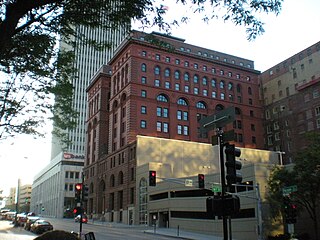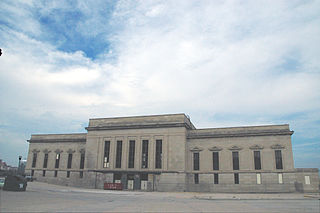Related Research Articles

A cable car is a type of cable railway used for mass transit in which rail cars are hauled by a continuously moving cable running at a constant speed. Individual cars stop and start by releasing and gripping this cable as required. Cable cars are distinct from funiculars, where the cars are permanently attached to the cable.

A tram is a rail vehicle that runs on tramway tracks along public urban streets; some include segments of segregated right-of-way. The lines or networks operated by tramcars as public transport are called tramways or simply tram/streetcar. Historically the terms electric street railways and trolley were also used in the United States. In the United States, the term tram has sometimes been used for rubber-tired trackless trains, which are unrelated to other kinds of trams.

A horsecar, horse-drawn tram, or (U.S.) horse-drawn streetcar, is an animal-powered tram or streetcar.
Ezra Millard was a U.S. politician who was mayor of Omaha, Nebraska, from 1869 to 1871. He was also brother to Joseph Hopkins Millard, another mayor of Omaha, and namesake of Millard, Nebraska.

Millard is a former town and current neighborhood in southwest Omaha, Nebraska; the original downtown area is near Millard Avenue and L Street.
The City of Birmingham Tramways Company Ltd operated trams in Birmingham, England, from 1896 until 1911.

The history of Omaha, Nebraska began before the settlement of the city, with speculators from neighboring Council Bluffs, Iowa staking land across the Missouri River illegally as early as the 1840s. When it was legal to claim land in Indian Country, William D. Brown was operating the Lone Tree Ferry to bring settlers from Council Bluffs to Omaha. A treaty with the Omaha Tribe allowed the creation of the Nebraska Territory, and Omaha City was founded on July 4, 1854. With early settlement came claim jumpers and squatters, and the formation of a vigilante law group called the Omaha Claim Club, which was one of many claim clubs across the Midwest. During this period many of the city's founding fathers received lots in Scriptown, which was made possible by the actions of the Omaha Claim Club. The club's violent actions led to the U.S. Supreme Court trial, Baker v. Morton, which led to the end of the organization.

The Omaha National Bank Building was built in 1888–89 at 1650 Farnam Street in Downtown Omaha, Nebraska. Built in the Italian Renaissance style, the building was saved from demolition by a rehabilitation in 1978. Listed on the National Register of Historic Places in 1972, the building was originally known as the New York Life Insurance Building; it was renamed in 1906.

The history of trams, streetcars, or trolleys began in the early nineteenth century. It can be divided up into several discrete periods defined by the principal means of motive power used.
The Union Stockyards of Omaha, Nebraska, were founded in 1883 in South Omaha by the Union Stock Yards Company of Omaha. A fierce rival of Chicago's Union Stock Yards, the Omaha Union Stockyards were third in the United States for production by 1890. In 1947 they were second to Chicago in the world. Omaha overtook Chicago as the nation's largest livestock market and meat packing industry center in 1955, a title which it held onto until 1971. The 116-year-old institution closed in 1999. The Livestock Exchange Building was listed on the National Register of Historic Places in 1999.

Herman Kountze was a powerful and influential pioneer banker in Omaha, Nebraska, during the late 19th century. After organizing the Kountze Brothers Bank in 1857 as the second bank in Omaha, Herman and his brothers Augustus, Charles and Luther changed the charter in 1863, opening the First National Bank of Omaha that year. Kountze was involved in a number of influential ventures around Omaha, including the development of the Omaha Stockyards and the Trans-Mississippi and International Exposition of 1898. Immediately after his death Kountze was regarded as one of Omaha's "old settlers". Today Kountze's First National Bank is the oldest bank west of the Mississippi River, and continues as a privately held company in its sixth generation of family ownership.

Frederick Krug was the German-immigrant founder of the Frederick Krug Brewing Company of Omaha, Nebraska. Krug is often cited as one of the early settlers of Omaha. In addition to operating the brewery for almost the entire duration of his life, Krug operated Krug Park in the Benson community and was the president of the Home Fire Insurance Company, which was founded in Omaha in 1884.

Transportation in Omaha, Nebraska, includes most major modes, such as pedestrian, bicycle, automobile, bus, train and airplane. While early transportation consisted of ferries, stagecoaches, steamboats, street railroads, and railroads, the city's transportation systems have evolved to include the Interstate Highway System, parklike boulevards and a variety of bicycle and pedestrian trails. The historic head of several important emigrant trails and the First Transcontinental Railroad, its center as a national transportation hub earned Omaha the nickname "Gate City of the West" as early as the 1860s.

Railroads in Omaha, Nebraska, have been integral to the growth and development of the city, the state of Nebraska, the Western United States and the entire United States. The convergence of many railroad forces upon the city was by happenstance and synergy, as none of the Omaha leaders had a comprehensive strategy for bringing railroads to the city.

The Upper Douglas Cable Tramway was a tram line serving all points between the southern end of the promenade and the upper part of the town of Douglas in the Isle of Man. It opened on 15 August 1896 and closed on 19 August 1929.
The Omaha and Council Bluffs Railway and Bridge Company, known as O&CB, was incorporated in 1886 in order to connect Omaha, Nebraska with Council Bluffs, Iowa over the Missouri River. With a sanctioned monopoly over streetcar service in the two cities, the O&CB was among the earliest major electric street railway systems in the nation, and was one of the last streetcar operators in the U.S., making its last run in 1955.
William A. Paxton was an American pioneer businessman and politician in Omaha, Nebraska. His life as a rancher and cattleman early in his life, as well as early work with the Union Pacific Railroad was highly regarded among his contemporaries; his success as a businessman later in his life led him to great wealth. His leadership is seen as an essential factor in Omaha becoming a prominent stockyards and meatpacking center. He is frequently referred to as "the real founder of South Omaha."
The Omaha Horse Railway was a private transportation company in early Omaha, Nebraska. The company was founded in 1867 by Omaha pioneers Ezra Millard, Andrew J. Hanscom and Augustus Kountze to provide horsecar service in the city. On February 19 of that year the Nebraska Territory Legislature awarded the company a 50-year franchise and exclusive rights to run tracks on Omaha's streets in its closing session. The company was noted for an 1888 United States District Court trial in which they sued another company for infringing on the exclusive rights to Omaha's streets granted to them by the Nebraska Territory Legislature.

The Northampton Street Tramways Company operated a horse powered tramway service in Northampton between 1881 and 1901.
References
- ↑ "Where and when did cable cars operate?". The Cable Car Homepage. Retrieved 2007-09-23.
- ↑ Larsen, L.H. & Cottrell, B.J. (1997). The Gate City: A History of Omaha. University of Nebraska Press. p. 107.
- ↑ "Omaha Began Early to Develop Its Role as Packing Center". Omaha's First Century. Omaha World-Herald. 1954. Retrieved 2007-09-23.
- ↑ "Street names". Douglas County Historical Society. Archived from the original on 2007-10-21. Retrieved 2007-09-23.
- ↑ "The Late Ezra Millard". Omaha Illustrated: A history of the pioneer period and the Omaha of today. Omaha, Nebraska: D.C. Dunbar & Co. 1888. Retrieved 2007-06-24.
- ↑ "Samuel R. Johnson: Santa Clara Biography". Santa Clara Biographies. Retrieved 2007-09-23.
- ↑ Wyman, B. (1902). Cases on Restraint of Trade. Harvard Law Review Publishing Company. pp. 23.
- ↑ "Omaha Timeline". Douglas County Historical Society. Archived from the original on 2007-09-27. Retrieved 2007-09-23.